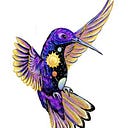A Second Star Appeared One Morning by E.G. Morse
June 2020| Utopia Science Fiction Magazine
It’s the middle of the Middle Stone Age and Homo Sapiens aren’t alone. Neanderthals still share the world with modern man. In fact, so did the Denisovans and a few other related hominids. The mass extinction about to be caused by the eruption of a supervolcano Toba in Sumatra, Indonesia had yet to occur. Upon erupting, the supervolcano shot 650 miles of vaporized rock into the air, becoming the largest volcanic eruption we know of on earth. It nearly caused all humans to go extinct. Our population worldwide dropped down to just several thousand individuals. Heralding in this devastating event any being looking up at the dazzling night sky would see something incredibly strange and wondrous. A sight which could only be interpreted as a sign that the end-times were near. A second sun was approaching the earth.
This sun was in actuality two stars, a red and brown dwarf, both trapped in a cosmic dance, named Scholz’s Star. In 2015 a group of researchers measuring this binary’s motion and velocity were able to extrapolate its flight path. They discovered Scholz’s Star grazed by our sun about 70,000 years ago. It came within 0.8 light-years of our own sun. For reference the closest star to us is Proxima Centauri which lays a comfortable 4.3 light-years away. Scholz’s star came close enough to brush against our Oort cloud. And to our ancestors gazing upwards, it would have appeared as a faint ruddy orb, as bright as the moon, visible day and night.
Again in 2018 further evidence was found to suggest this interaction happened. A team of researchers led by Carlos de la Feunte Marcos from the Complutense University in Madrid analyzed 340 known solar bodies with hyperbolic orbits. A body with a hyperbolic orbit takes neither circular nor elliptical paths through space. Instead the paths they follow are V-shaped.
“Using numerical simulations, we have calculated the radiants or positions in the sky from which all these hyperbolic objects seem to come,” de la Fuente Marcos said. “In principle, one would expect those positions to be evenly distributed in the sky, particularly if these objects come from the Oort Cloud,” he added. “However, what we find is very different: a statistically significant accumulation of radiants. The pronounced over-density appears projected in the direction of the constellation of Gemini, which fits the close encounter with Scholz’s star.”
While it’s possible the study notes, that these hyperbolic orbiting objects could be rogue neighbors caught in our orbit, the way they distribute and fit so well with the calculation of the team makes it seem unlikely. Interstellar brushes with other stars aren’t unheard of, though they are rare. In case you’re wondering there’s another stellar neighbor that’s on a course to brush by the sun and this time it will be significantly closer. Gliese 710 is expected to do the same as Sholz’s Star, except that it will pass at a distance of about 10,000 AU, about five times closer than the binary system our ancestors saw. Not to worry, we have another 1.5 million years to wait before this happens.
The results of the studies can be read in full in the two journals in which they were published in for those seeking more precise information.
- Carlos de la Fuente Marcos, Raúl de la Fuente Marcos, Sverre J Aarseth. Where the Solar system meets the solar neighbourhood: patterns in the distribution of radiants of observed hyperbolic minor bodies. Monthly Notices of the Royal Astronomical Society: Letters, 2018; 476 (1): L1 DOI: 10.1093/mnrasl/sly019
- Eric E. Mamajek, Scott A. Barenfeld, Valentin D. Ivanov, Alexei Y. Kniazev, Petri Väisänen, Yuri Beletsky, Henri M. J. Boffin. The closest known flyby of a star to the solar system. The Astrophysical Journal, 2015; 800 (1): L17 DOI: 10.1088/2041–8205/800/1/L17
Originally published in the June 2020 issue of Utopia Science Fiction Magazine
E.G. Morse A member of the Royal Astronomical Society of Canada, E.G. Morse worked for a while at the David Dunlap Observatory near Toronto. Now they recline in retirement and does occasional freelance work writing science articles on astronomy.
